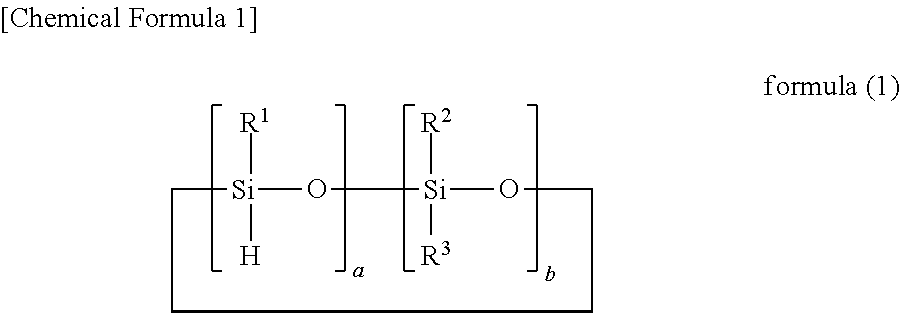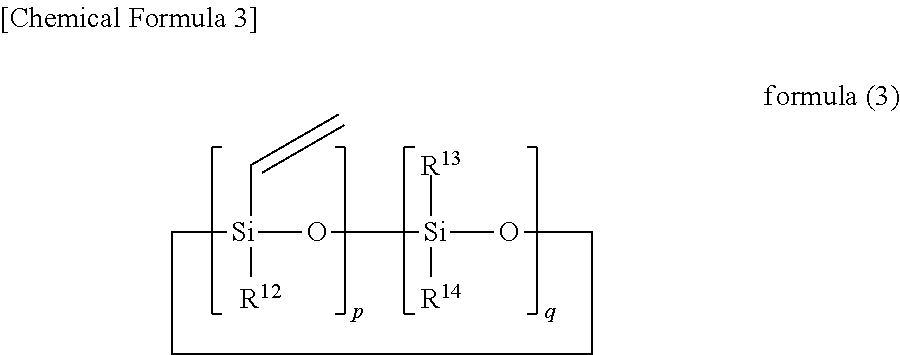Silicon-containing curable composition and cured product thereof
a technology of curable compositions and compositions, which is applied in the direction of coatings, etc., can solve the problems of limited use of curable compositions, insufficient heat resistance, colorability, adherence, etc., and achieve excellent heat resistance, excellent colorability and transparency, excellent heat resistance
- Summary
- Abstract
- Description
- Claims
- Application Information
AI Technical Summary
Benefits of technology
Problems solved by technology
Method used
Image
Examples
synthesis example 1
Component (A): Synthesis of Prepolymer 1
[0086]100 parts of 1,3,5,7-tetramethylcyclotetrasiloxane, 100 parts of divinylbenzene, 60 parts of toluene, and 0.0005 parts of a platinum-carbonylvinylmethyl complex (Ossko catalyst) were mixed, and while stirred, the mixture was heated to reflux for 5 hours. The solvent was distilled off under reduced pressure from the reaction liquid at 70° C., and thus a prepolymer 1, which is the component (A), was obtained.
[0087]An analysis by GPC was carried out, and as a result, the molecular weight of the prepolymer 1 was Mw=10,000, while the content of hydrosilyl groups (Si—H groups) as obtained by 1H-NMR was 5.3 mmol / g.
synthesis example 2
Component (A): Synthesis of Prepolymer 2
[0088]100 parts of 1,3,5,7-tetramethylcyclotetrasiloxane, 50 parts of divinylbenzene, 70 parts of 1-methoxy-2-propanol acetate, and 0.0001 parts of a platinum-carbonylvinylmethyl complex (Ossko catalyst) were mixed, and while stirred, the mixture was heated to reflux for 6 hours. The solvent was distilled off under reduced pressure from the reaction liquid at 50° C., and thus a prepolymer 2, which is the component (A), was obtained.
[0089]An analysis by GPC was carried out, and as a result, the molecular weight of the prepolymer 2 was Mw=140,000, while the content of hydrosilyl groups (Si—H groups) as obtained by 1H-NMR was 5.2 mmol / g.
synthesis example 3
Component (B): Synthesis of Cyclic Siloxane Compound
[0090]In a liquid mixture obtained by mixing and stirring 300 parts of 1,4-dioxane and 300 parts of hydrochloric acid, a mixture of 210 parts of methylvinyldichlorosilane and 90 parts of phenylmethyldichlorosilane was added dropwise. The mixture was allowed to react at room temperature for 30 minutes, and then was allowed to react at 70° C. for 3 hours, while the hydrochloric acid generated by a hydrolysis reaction was collected. After the reaction, between the liquid layers separated into two layers, the upper layer was subjected to purification by distillation under the conditions of 120° C. to 140° C. under a reduced pressure provided by a vacuum pump, and thus a cyclic siloxane compound 1 represented by the formula (5) described above, which is the component (B), was obtained.
[0091]An analysis was carried out by GC-MS, and as a result, the cyclic siloxane compound 1 contained a compound having a molecular weight of 395 at a pro...
PUM
| Property | Measurement | Unit |
|---|---|---|
| temperature | aaaaa | aaaaa |
| mass ratio | aaaaa | aaaaa |
| mass ratio | aaaaa | aaaaa |
Abstract
Description
Claims
Application Information
 Login to View More
Login to View More - R&D
- Intellectual Property
- Life Sciences
- Materials
- Tech Scout
- Unparalleled Data Quality
- Higher Quality Content
- 60% Fewer Hallucinations
Browse by: Latest US Patents, China's latest patents, Technical Efficacy Thesaurus, Application Domain, Technology Topic, Popular Technical Reports.
© 2025 PatSnap. All rights reserved.Legal|Privacy policy|Modern Slavery Act Transparency Statement|Sitemap|About US| Contact US: help@patsnap.com



